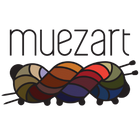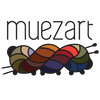Different Uses Of Embroidery Threads
Are you fond of how different embroidery works?
Are you wondering about what are the uses of embroidery threads?
If yes, then this blog will help you explore the different uses of Eri silk embroidery threads and the types of embroidery patterns.
Also, when you consider the number of hours you will spend on a needlework project, you will see the importance of using good quality embroidery.
In this blog, you will learn the various ways of using the wonderful Eri silk threads for embroidery.
Before getting into the details on the uses of embroidery threads, let me tell you about Muezart's Special silk Embroidery Threads.

Our natural hand-dyed embroidery thread is tightly twisted, has a beautiful texture, and behaves like Perle cotton. It is a 2-ply thread that results in giving your project a textured effect.
Our unique Eri silk embroidery thread kit consists of 11 colors, that are hand-dyed using plant-based ingredients.
These beautiful embroidery threads are S-twisted and work great on a rustic middleweight fabric or light, thin fabric.
Using our 2-ply Eri silk embroidery threads, you can create lovely, uniform finish for your hand embroidery designs. These silk threads are suitable for cross stitch, freestyle embroidery, needlepoint, etc.
Hand embroidery designs are usually seen on caps, hats, coats, blankets, dress shirts, denim, dresses, stockings, and golf shirts-, and sometimes on a project which will be displayed as art on the wall.
With no further ado, let me tell you what the uses of embroidery threads are:
1. Cross Stitching
Embroidery threads can be used for cross-stitching. Cross-stitch is a form of sewing and a popular form of counted thread embroidery in which X-shaped stitches in a tiled, raster-like pattern are used to form a picture.
Cross embroidery stitch is making a comeback among modern makers and crafters. Learning how to cross stitch is easy, and these instructions for beginners will help you in stitching right away.
2. Counted- Thread Embroidery
Counted-thread Embroidery is any hand embroidery design in which the embroiderer counts the embroidery threads before inserting the needle into the fabric. A balanced fabric, one in which the warp and weft are of the same size, is usually used; and thus, It produces a symmetrical image.
3. Needlepoint
Needlepoint is a type of canvas work, a form of counted thread embroidery in which embroidery thread is stitched through a stiff open weave canvas.
Traditionally needlepoint embroidery designs completely cover the canvas. Although needlepoint may be worked in a variety of stitches, many needlepoint designs use only a simple tent stitch and rely upon color changes in the embroidery threads to construct the pattern. Needlepoint embroidery stitch is the oldest form of canvas work.
4. Punch Embroidery
Punch Needle Embroidery is a form of embroidery work that's also related to rug hooking. Instead of stitching through the fabric, the punch needle pushes the silk embroidery threads or yarn into the fabric, while keeping the embroidery needle on the surface.
5. Quilting
Hand Quilting uses a needle and embroidery threads to sew a running stitch by hand across the entire fabric or cloth area to be quilted, which binds the layer together.
You can use a quilting hoop to assist in holding the piece being quilted on your lap.
6. Patchwork
Hand embroidery threads can be used for various patchwork projects like making rugs, wall hangings, bags, warm jackets, cushion cover. Textile artists use embroidery threads for any embroidery patchwork.
7. Sashiko
The word Sashiko means "little stabs" and refers to the small embroidery stitches used in this form of needlework.
Sashiko is a form of Japanese folk embroidery design using the basic running stitch to create a patterned background.
Sashiko embroidery work is commonly used to create decorative and repeated hand embroidery patterns. It may be used for purely decorative purposes and used to reinforce points of wear or to repair worn or tears parts of the cloth with patches.
8. Shisha embroidery
Shisha Embroidery pattern is a technique of stitching the border around small pieces of metal or glass with embroidery threads to attach them to the fabric.
Shisha or mirror embroidery pattern is commonly found in various states like Bihar, Karnataka, Madhya Pradesh, and Manipur, where each state has specialized in certain mirror work items.
9. Kantha Embroidery
Kantha, a popular style of Embroidery from West Bengal, is a significant symbol that displays the rural women's skill and talent in Bengal.
Traditionally this thread embroidery design is used for quilts, dhotis, and sarees, but over a period of time, it has evolved and made its way right into the heart of Indian fashion.
10. Bead Embroidery
Bead Embroidery design is a type of beadwork that uses a needle and embroidery thread to stitch beads to a surface of fabric, suede, or leather. Bead embroidery work is an embellishment that does not form an essential part of a textile's structure. In this respect, bead embroidery work differs from bead weaving, bead crochet, and bead knitting stitches.
11. Applique Embroidery
Applique embroidery design is done with hand or a sewing machine, and by placing fabric on the material you are using as the background and forming a new pattern. When you are satisfied with the applique positioning, you just sew around the edges along with the background cloth.
Patches of applique can be made into really nice tabletops or to decorate wooden photo frames. You can decorate other home decorative pieces too with applique embroidery. They can also be very colorful and fun gifts for children and grown-ups alike.
I hope this helps you get a brief knowledge of the uses of Eri silk embroidery threads and creating various embroidery thread designs.
Inspired by some of the uses of Eri silk embroidery patterns?
Why not check our Embroidery threads to get started with your project?

















Thank you so very much for your post, so informative as I am trying to learn embroidery as are others. Have not been particularly impressed with what supplies are found in the needlework sections. Just visit- https://www.doree.com.au/our-services/embroidery/
I’ve read your article. Honestly, I’ve never read this type of informative and efficient article before. This article will help lots of beginners like me to build skills in embroidery. Love to read your incoming blogs too. Really appreciate your work and dedication.
We have digitizing in usa to fulfill your embroidery needs.
Leave a comment